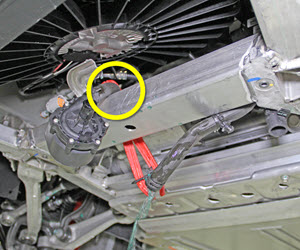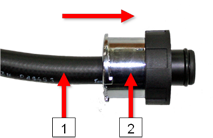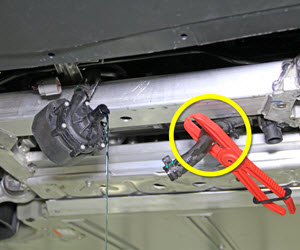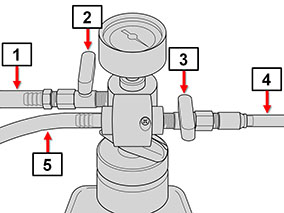Drain
- Prepare the vehicle for lifting, but do not raise the vehicle at this time.
-
Use Toolbox to prepare the vehicle for draining and refilling coolant:
- Connect a laptop with Toolbox 2.0 or higher to the vehicle.
- Oen the "Fluid Drain and Fill" panel.
- Check the "Coolant Panel" check box.
- In the "Routine" dropdown menu, select Fluid Drain/Fill.
- Press the Start/Play button.
Note: Before continuing this procedure, inspect the "Thermal" mode readout on the
touchscreen and ensure that the powertrain and battery systems are in "series"
mode"
- Remove the HEPA filter duct (refer to procedure).
- Disconnect 12V power (refer to procedure).
- Remove the front aeroshield (refer to procedure).
- Disconnect the low voltage harness from battery coolant pump 1.
- Slide the coolant pump off of the subframe bracket.
- Release the barrel clip on the inlet coolant hose from the top of the subframe.
- Place a coolant catcher beneath the coolant pump.
-
Clamp the outlet coolant hose. Release the inlet cooling hose from the pump and allow the
coolant to drain into the coolant catcher.
Tip: Move the inlet hose behind the subframe crossmember.
- As coolant continues to drain, lower the vehicle.
- Install the reservoir adapter into the reservoir.
-
Insert the rubber hose on the pressure tester into the rubber grommet in the
coolant reservoir adapter. Push the hose into the grommet until it is
secure.
1 Pressure tester 2 Coolant reservoir adapter - Make sure the valve on the Battery Cooling System Pressure Tester is closed (the handle is perpendicular to the valve).
- Connect the Battery Cooling System Pressure Tester to a compressed air line.
-
Set the pressure regulator on the Battery Cooling System Pressure Tester to 5 psi (0.34
Bar).
Caution: Do not exceed 5 psi (0.34 Bar) or damage to the battery might result.
- Slowly open the valve on the pressure tester. When enough coolant has been removed so that the flow has been reduced to a slow drip, close the regulator.
- Raise the vehicle.
- Clamp the inlet coolant hose.
-
Release the clamp on the outlet coolant hose. Allow coolant to drain from the pump into
the coolant cacher.
1 Pressure tester 2 Coolant reservoir adapter - As coolant continues to drain, lower the vehicle.
-
Set the pressure regulator on the Battery Cooling System Pressure Tester to 5 psi (0.34
Bar).
Caution: Do not exceed 5 psi (0.34 Bar) or damage to the battery might result.
- Slowly open the valve on the pressure tester. When enough coolant has been removed so that the flow from the pump has been reduced to a slow drip, close the regulator.
- Raise the vehicle.
- Secure the hoses to the pump, then reinstall the pump onto the subframe bracket.
- Reconnect the low voltage harness to the coolant pump.
Note: Do not reinstall the front
aeroshield at this time.
- Lower the vehicle.
- Remove the pressure tester from the vehicle.





